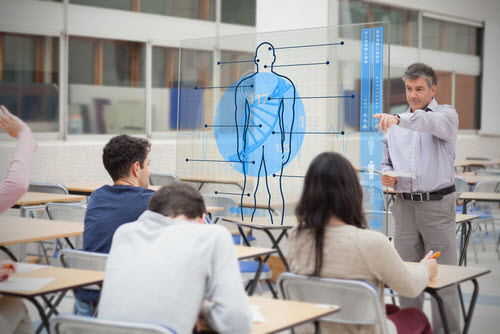What will the Classroom of the Future Look Like?
What will the Classroom of the Future Look Like?
 If we could look into a crystal ball and take a peek at what the future classroom would look like, what would we see? With so much technology just being invented today, it is difficult to tell. But it is likely that it would include a number of these elements: About 35% of students are learning online today, rather than the traditional educational model. This, coupled with the vast array of technological inventions to aid in the theoretical acquisition of the new technologies is pushing more public and secondary education institutions to continue to push the envelope of change.
If we could look into a crystal ball and take a peek at what the future classroom would look like, what would we see? With so much technology just being invented today, it is difficult to tell. But it is likely that it would include a number of these elements: About 35% of students are learning online today, rather than the traditional educational model. This, coupled with the vast array of technological inventions to aid in the theoretical acquisition of the new technologies is pushing more public and secondary education institutions to continue to push the envelope of change.
- Satellite delivery models – With increasing attention being given to satellite delivery models such as distance learning technology, schools are moving away from a teacher-directed model and towards a model that focuses more on student achievement and technology-based acquisition of skills. Foreign language components will be worked into this infrastructure, especially in public schools to handle the language barrier we see today in education.
- Everything HD quality – The move toward better digital technology as well as better, clearer quality in learning delivery models demands that all video and audio quality be superior. Gone are the days when we waited 60 seconds for video to download. Modern day and future education environments will demand much higher quality technology to drive the system, as learners become much more time and digital quality conscious.
- Students as Directors – In public schools, there will be a move more toward students doing much of their own technology, including video production, overhead presentations as learning modules, and more student-directed activities which are spurred by the new technological advances.
- Online grading systems – Grading systems will move more to the cloud, as has been the trend for several years now. With more online grading models to choose from and improved software automation capabilities, more public and secondary schools will opt to move to online grading systems due to the convenience of this system in general, and the promptness and instant access it gives to both students and teachers.
- Special learners achieving higher – With more advances in technology which appeal to the lower learner, a positive thing that should come out of this is the ability of technology to appeal to the challenged learner by offering multiple ways to instruct.
- Distance learning – Distance learning will become more widely used both in public K-12 environments as well as university level learning.
- Competency based learning – Learning will be based more on the level of competency and will be more student-focused than in the past, because there will be more access to technology that can help remediate skills that are in the student’s weak areas.
- Mobile technology – Just as is true in the online sales markets, we will start to see mobile technology used more by students in high school as well as college level. There will likely be less strict rules regarding the use of such mobile devices, due to its ability to allow students to take learning with them.
- Open Source Software Solutions – Linux and other open source software solutions are making a comeback slowly but surely, as users see the value in not having to deal with licensing fees and other red tape in multiple licenses for schools. When the open source software starts to improve more over the long haul, we will start to see this model being more widely accepted by schools and universities.
PROBLEMS WITH DELIVERY
Some of the problems involved in the coming of the technology age to education will include:
- Technical Issues
- Language Barriers
- Budget limitations
THE PUBLIC RESISTANCE FACTOR
In addition to the above potential issues, there will likely be public resistance to some of the new methods. Educating the public first, before unveiling some of these new trends will ultimately be the key to public acceptance in understanding that the new model will be more successful than its “chalk and green board” predecessor.
TOO MUCH INFORMATION
*Individuality of different schools is an added challenge due to the fact that each school is different in its needs and delivery models. How schools use the tools is ultimately up to each school, but we can only continue to suppose what the school of the future will look like, based on the current trends and the future technology, some of which has yet to be invented.







